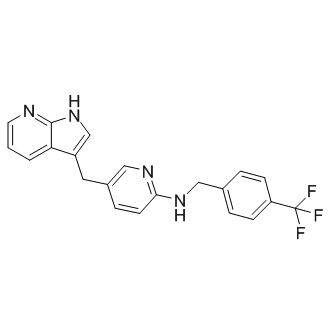| Cas No.: | 873786-09-5 |
| Synonyms: | PLX 647,PLX-647 |
| SMILES: | C(NCC1=CC=C(C(F)(F)F)C=C1)1=NC=C(CC2C3=CC=CN=C3NC=2)C=C1 |
| Formula: | C21H17F3N4 |
| M.Wt: | 382.38 |
| Purity: | >98% |
| Sotrage: | 2 years -20°C Powder, 2 weeks 4°C in DMSO, 6 months -80°C in DMSO |
| Description: | PLX647 is a highly specific dual FMS/KIT kinase inhibitor with IC50 of 28/16 nM respectively. |
| Target: | IC50 value: 28/16 nM(FMS/KIT) [1] Target: FMS/KIT dual inhibitor |
| In Vivo: | PLX647 (40 mg/kg) was dosed orally 4.25 h before LPS injection. Treatment with PLX647 reduced serum TNF-α levels by 85% compared with the vehicle control. In the same experiment, the positive control dexamethasone (0.5 mg/kg, PO) lowered the TNF-α levels by 96%. Treatment with 40 mg/kg PLX647 also resulted in significant inhibition of IL-6 release (75%), with similar potency to dexamethasone (70%) . In the UUO kidneys, treatment with PLX647 [40 mg/kg twice daily (BID)] resulted in reduction in the levels of F4/80+ macrophages by 77% compared with vehicle [1]. |
| In Vitro: | PLX647 was tested against a panel of 400 kinases at a concentration of 1 μM, 35-fold above its FMS enzymatic IC50 and 60-fold above its KIT enzymatic IC50. In addition to FMS and KIT, the activities of only nine kinases were inhibited by more than 50%. PLX647 potently inhibits the growth of FLT3–ITD-expressing MV4-11 cells (IC50 = 0.11 μM) but not OCI-AML5 (IC50 = 1.6 μM), which express wild-type FLT3. PLX647 displayed minimal inhibition of the proliferation of Ba/F3 cells expressing BCR–KDR (IC50 = 5 μM) [1]. |
| References: | [1]. Zhang C, et al. Design and pharmacology of a highly specific dual FMS and KIT kinase inhibitor. Proc Natl Acad Sci U S A. 2013 Apr 2;110(14):5689-94. [2]. Louvet C, et al. Tyrosine kinase inhibitors reverse type 1 diabetes in nonobese diabetic mice. Proc Natl Acad Sci U S A. 2008 Dec 2;105(48):18895-900. |

 DC Chemicals' products qualify for U.S. tariff exemptions. We guarantee no price increases due to customs duties and maintain stable supply, continuing to deliver reliable research solutions to our American clients.
DC Chemicals' products qualify for U.S. tariff exemptions. We guarantee no price increases due to customs duties and maintain stable supply, continuing to deliver reliable research solutions to our American clients.





















